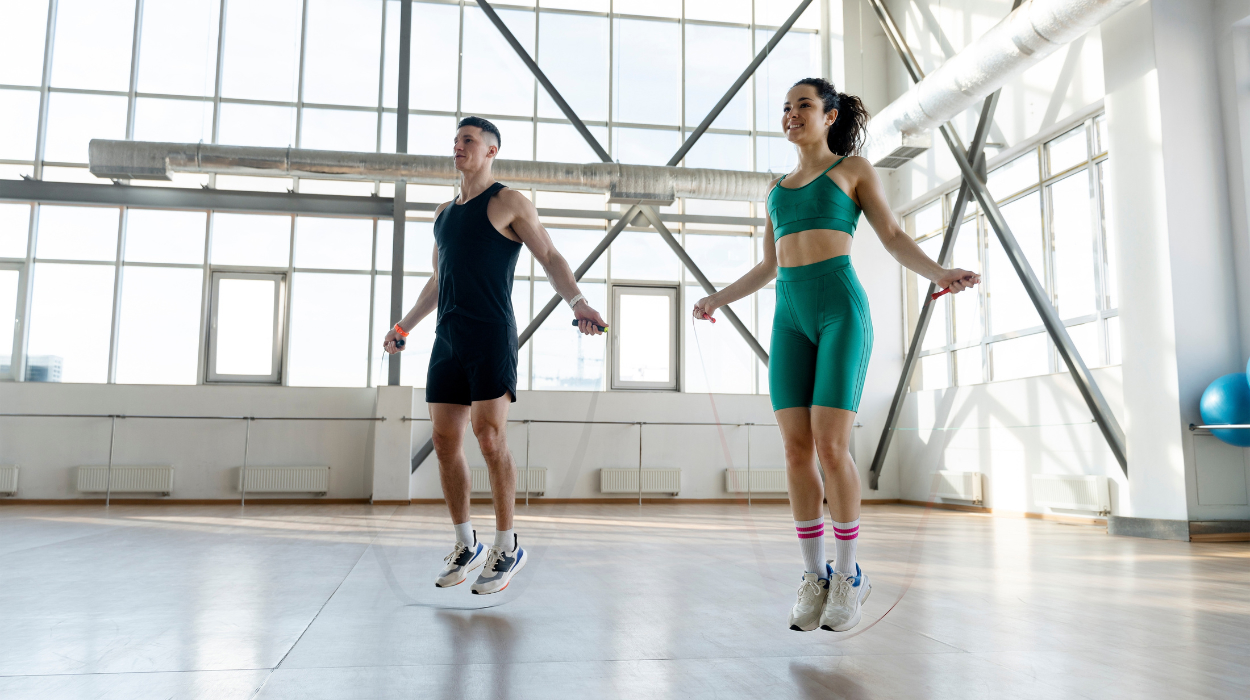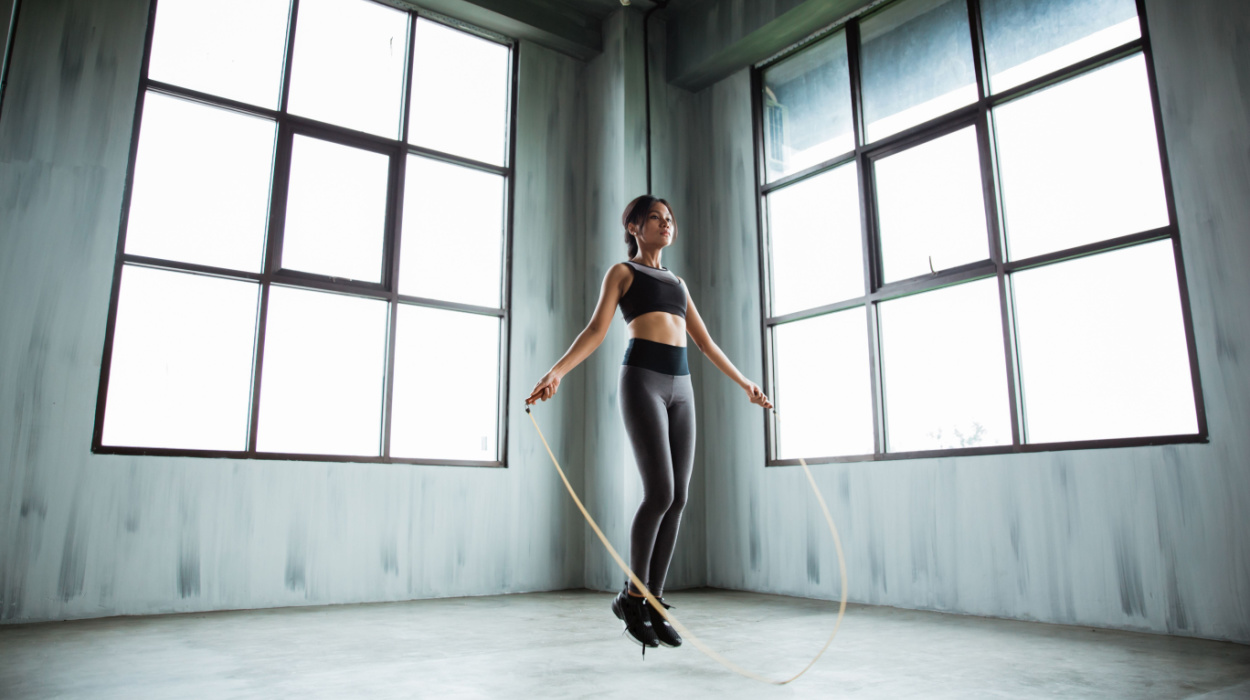Did you know that you can jump your way out of obesity? Jumping rope can help you learn how to lose weight and burn fat if you are consistent.
You may associate jumping rope with being a kid, but it can be implemented into nearly any workout routine or just enjoyed on its own.
You can do a jump rope workout to lose weight at home or anywhere else where you are comfortable. This makes it easy. Combine this exercise with a healthy diet and tools like a fat burner for the best results.
This article will explore how to jump rope to lose weight. We will also answer the question, “How long does it take to lose weight?” and show you the best ways to jump rope. It is time to dive in.
How To Jump Rope To Lose Weight
Jumping rope and how you incorporate it into your exercise strategy will result in weight loss, based on the following:
- Do interval training.
- Utilize full-body engagement.
- Increase frequency, intensity, and duration as fitness improves.
- Include varied techniques.
- Follow proper nutrition.
- Combine with strength training.
- Set realistic goals.
- Be consistent.
8 Best Ways To Jump Rope To Lose Weight

There are numerous strategies to do the jump rope workout for weight loss and get the best outcome. This section includes eight effective ways to use your jump rope workout as a fat burner.
Do Interval Training
Interval training[1] is a technique that comprises high-intensity exercises with periods of rest in between. This technique helps increase your body’s metabolism to burn more calories faster. It also ensures that you do not over-exercise and reduces the chance of overuse injuries.
You can carry out high-intensity interval training, or HIIT, by switching between intense bounces using basic jumps and short breaks.
Utilize Full-Body Engagement
Contrary to popular belief, jumping rope is not only a leg workout. It also engages the core, arms, and shoulders.
Your abdominals are used to stabilize your core during the movement. Your arms and shoulders help swing the rope in the required forward motion.
Several jump rope techniques allow you to move different parts of your body. This exercise tends to maximize full body involvement to boost calorie burn. Make sure to begin with your upper body standing straight with knees slightly bent in the starting position before you begin your full-body workout.
Increase Frequency, Intensity, And Duration Over Time
You may predispose yourself to injuries if you start with high-intensity workouts. Start off by using a low-intensity and simple workout with the jump rope and jumping straight a few inches off the floor while gradually progressing frequency, intensity, and duration over time as fitness improves.
Doing this allows your body to adapt and get ready for more movements. You can make the workouts more difficult over time. Try adding time, speed, and intensity while reducing rest breaks, as it makes sense for burning calories.
Include Varied Techniques
You can make your workout more fun by trying different jump techniques. These include double-unders, single-leg jumps, forward jumps, criss-cross, switch feet, or even high knees.
It is important to switch techniques to avoid getting bored and to engage different muscle groups during workouts. This makes it more efficient and helps burn fat mass. Swing the rope fluidly using a forward jump so you don’t trip yourself; work on balance.
Follow Proper Nutrition
Without proper nutrition, you will lack the required nutrients to repair your muscles and tissues after exercising and to change your body composition. Ensure you eat a diet of lean protein, whole grains, healthy fats, fruits, and vegetables according to your weight loss targets.
Combining this with physical exercise constitutes a full-scale, integrative way of losing weight. Even if you decide to use diet pills and weight loss supplements, you should still go hard on balanced meals.
Combine With Strength Training
Incorporate jump rope into weight-bearing exercise at a consistent pace and at a high enough intensity to get your heart pumping. Combining these two exercise elements gives you a cardio workout to improve blood circulation and bone mineral density. You also get a muscle-building exercise that can support weight loss as well.
Set Realistic Goals
Trying to lose weight and achieve physical fitness with jump ropes is not an overnight weight-loss scheme. Set realistic goals and be patient with your progress.
Be Consistent
You will hardly see any results if you fail to work out consistently. Sustainable weight loss or management and improved health are tied to consistency. Therefore, resolve to stick to a schedule; a workout accountability partner can also help you stay on track.
Benefits Of Jumping Rope

Optimal Weight Maintenance
One of the benefits of jumping rope is that it is among the easiest ways anyone can use to maintain their desired weight level. It is a dynamic activity that involves many muscle groups. Therefore, the activity burns extra calories.
Studies indicate that engaging in physical activity[2] may be crucial in maintaining your achieved weight after shredding fat.
Physical Fitness
Jumping rope improves your general physical condition, including optimal organ functioning, muscular power, and coordination. Simple yet effective exercises like jumping rope enhance agility, balance, and flexibility. These benefits also impact your cognitive abilities[3] favorably.
A 2018 study indicates that jump training, in addition to other exercises, improves muscular power[4] in older adults. Additionally, a 2014 meta-analysis shows that jumping exercises significantly improve bone mineral density[5] among people other than those in menopause or perimenopause.
Jumping is a repetitive movement that helps you hone motor skills and builds up leg, core, and arm muscles. Jump rope exercises are versatile because you can modify them in terms of jump style or intensity such that people with specific fitness objectives can exercise accordingly.
Cardiovascular Health
Another benefit of jumping rope is the improvement of cardiovascular health as it is a cardio exercise. The heart rate is increased during this aerobic exercise, making your heart pump more blood for better oxygenation of muscles. This can enhance blood circulation and reduce your chances of heart disease.
A study on middle school boys reveals that seven weeks of jump rope training improves cardiovascular endurance and agility.[6] There is also scientific evidence that the cardiovascular benefits of jumping rope include improving lung capacity.[7]
How Long Should You Jump Rope To Lose Weight?
How long to jump rope to lose weight depends on factors such as your fitness goals and individual fitness level. However, try to aim for about 15 to 30 minutes per session. As your fitness levels increase, you can progress into jumping for longer periods.
Based on your individual fitness level, here is how you can extend the duration of your jump rope routine.
Beginner Level
First, start with brief sessions. For instance, use 15 minutes to allow your body to become accustomed to the physical exercises. Ensure that you have good form as you jump. Make sure that these jumps are at a uniform pace.
At your initial stage of training, you need two or three sessions per week until you increase your jump duration.
Intermediate Level
You can then graduate to 20 to 30 minutes after your stamina and endurance improve. At this point, you can include different jump skills like high knees, double under, or cross jumps. These jump skills can ensure your body muscles are engaged while you burn calories.
Keep jumping at medium-to-hard levels during the session.
Advanced Level
Sessions may take longer than thirty minutes for high-level fitness. Jump as much as you can in a short span of time and take brief breaks to recover your energy. You should include various jumping techniques to target different muscle groups.
Risks & Safety Tips
It is important to note that jumping rope is generally a safe exercise. However, while jump roping to lose weight, listen to your body and avoid overexertion. This is especially important if you are new to it or have an underlying medical condition.
The following are common risks associated with the jump ropes:
- Impact on joints: The jump rope exercise can impact joints, especially the hips, knees, and ankles. If you have joint issues or a history of injuries, you should consult your doctor before starting jump rope workouts.
- The strain on calves and Achilles tendon: Due to the repetitive nature of jumping ropes, you can strain your calves and Achilles tendon.
- Tripping and falling: These are risks associated with jumping, especially if you are doing so with improper form. Attempting advanced techniques as a beginner can also cause you to trip and fall.
- Injuries: Exercising without adequate rest predisposes you to overuse injuries such as sprains.
Here are safety tips to keep in mind during your workouts:
Choose The Right Surface
Jump on a shock-absorbent surface, such as a rubberized gym floor, to reduce the impact on your joints.
Proper Footwear
Only wear athletic shoes that provide a cushioning effect to absorb the impact of jumping and reduce strain on your feet and ankles.
Appropriate Jump Rope Length
Ensure your jump rope is the correct length. Stand in the middle of the rope. Then let its handles get to your armpits.
An incorrectly sized rope can affect your form and increase the risk of tripping.
Warm-Up
Do warm-ups such as light cardio and dynamic stretches before jumping rope to prepare your muscles and joints. Warm-ups also help to increase blood flow and enhance flexibility.
Start Slowly
As a beginner, ensure you start with shorter jump sessions and then gradually increase intensity and duration. Starting at a slow pace allows your body to adapt to the demands of jumping rope.
Listen To Your Body
How your body feels during exercise is important, and you should pay attention to it. Check for discomfort, pain, or signs of overtraining, and take time for adequate rest. Consult with your doctor if you experience persistent pain.
Rest And Recovery
Prioritize adequate rest and allot time for recovery between your jumping sessions. This will help prevent overuse injuries and allow your body tissues to recover. If you listen to your body, you will know when you require a rest day from time to time.
Conclusion
The jump rope workout may appear too simple, misleading you into thinking it will have no effect on weight loss. However, numerous studies show that it does more than help you lose weight. It also helps to promote healthy weight maintenance and overall physical and cognitive fitness.
Jumping rope also assists in fine-tuning your coordination, increases your muscle strength, and strengthens your cardiovascular system.
As you jump into a healthy tomorrow, note that the advantages of this exercise extend beyond the ordinary level. The jump rope exercise is an example of how simplicity can combine with efficiency. This makes it a fun yet effective way to lose weight.
Therefore, if you are new to exercise, buying a jump rope is definitely one of the things that will move you toward an energized and healthy body.
Frequently Asked Questions
Jumping rope burns fat as long as you are consistent with your workouts. You also need to be in a calorie deficit so your body will use stored fat for energy.
How much you should jump rope to ensure you lose weight varies between individuals and your fitness level. Practice your jumps following a suitable duration for your fitness level.
Jumping rope can burn up to 1300 calories an hour, with a consumption of around 0.1 calories per hop.[8] It may take up to 5,000 to burn 500 calories. Results mostly depend on workout intensity and your weight.
Yes, you can jump rope for weight loss and get your desired result. It is important to be consistent with your regimen.
 Evidence Based
Evidence Based
